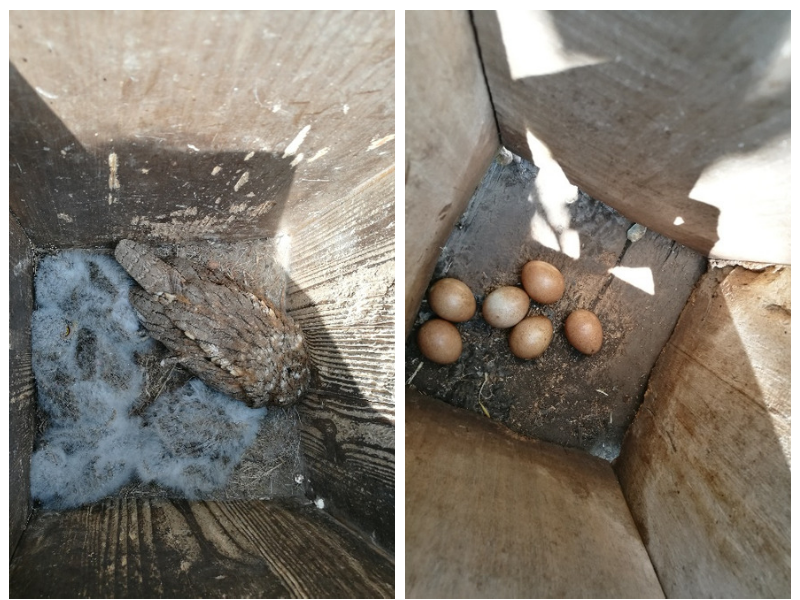Growing Roller population in Bükk National Park
Being long-term migrants, Rollers have already headed towards the southern parts of Africa. While some of them has already reached Sahel region, other individuals could have been still seen in the grasslands of Hungary in the past weeks. Number of Roller is growing year by year in the area of the national park directorate, mainly because of the nestboxes installed by professional staff. In this article we are going to detail the breeding results of Rollers in 2018.
Being cavity nesters, Rollers often occupy cavities of old trees made by cavity making species (eg. European Green Woodpecker) but also successfully use artificial, type D nestboxes for breeding. However, besides installing breeding platforms, the provision of proper feeding habitat is also essential for the species. Plantation of forest patches and treelines is among the main activities of the LIFE+ project “Conservation of European Roller in the Carpathian Basin” started in September, 2014. The aim is to support the nesting of Rollers in natural cavities in the future.

Typical Roller habitat in South-Heves region
The success of the project is verified by the fact that while 471 Roller pairs were breeding in the area of the national park directorate in 2017, their number reached 528 pairs in 2018. These numbers are the data of birds nesting in artificial nestboxes, the actual population size exceeds 550 pairs after adding the birds breeding in natural cavities.

Installation of new nestboxes and the results of the successful breeding: developing juveniles in an artificial nestbox.
Population growth is the result not only of habitat protection (and improvement) but also of the freshly installed 250 nestboxes in spring. Compared to previous years, this time new nestboxes were placed not only in the core areas (South-Heves, Mezőség) but in peripheral, foothill areas (Mátra, Bükkalja) as well. This way we expect to achieve the expanse of the breeding area of the species.
Nowadays the number of nestboxes in the national park directorate area exceeds 1100. Based on this data almost 50% of the nestboxes were occupied by Rollers in 2018. This is a fine ratio taking into consideration that freshly installed nestboxes has a reducing effect since normally those are not occupied immediately.
The 528 breeding Roller pairs fledged more than 950 juveniles. Most of the Rollers brood in Borsodi-Mezőség and South-Heves, but their number is constantly growing in Bükkalja, Mátraalja and Kesznyéten Landscape Protection Area as well.
Very good and surprising news of this year: a pair of Roller has been breeding in Nógrád county for the first time in centuries - next to the municipality of Palotás - in a new nestbox installed this spring. Number of Rollers is increasing year by year in Mátra and Eastern-Bükk district as well, 33 pairs were breeding in Mátraalja and 40 pairs in Bükkalja this year. Compared to the former 3-4 pairs this is a huge achievement.

Clutches of 6 chicks were not rare in 2018. The chicks were ringed.
Nestboxes are often successfully occupied by other species besides Rollers, too, of course. Following Roller, the second most frequent breeder in the nestboxes in 2018 were Common starling (179 pairs), making Eurasian Tree Sparrow the third (96 pairs). The number of nestboxes taken by wasps also increased compared to previous years. In 2018 in Mezőség a pair of Red-footed falcon was breeding in a type D nestbox, which return to breed in these nestboxes year after year. Breeding of Scops owl were found in 4 cases: 3 in Bükkalja and 1 in the area of South-Heves.

Left: adult Eurasian scops owl with 4 chicks in the nestbox, Right: clutch of Common Kestrel
Tagging juvenile Rollers with colour rings happened in parallel with the nestbox monitoring. We regularly have feedback on the tagged birds since we have started to use this method.
Breeding results of 2018 represents the importance of providing nesting opportunities, however the maintenance of feeding habitats is also of special importance. Therefore we continue the nestbox installations and the plantation of treelines and tree patches in the project.
We also would like to express our gratitude for everybody who contributed to the hard work of this years’ field season, namely: András Antal, Bettina Bata, Katalin Bodnár, Gábor Deák, György Dudás, István Elek, Katalin Fehér, Attila Ferenc, Tamás Frank, Gerda Gell, Gerhárd Golen, Krisztián Harmos, Sándor Jakab, Benedek Juhász, András Kleszó, Emese Korompainé Szitta, Gábor Magos, Márton Molnár, Andrea Anna Pálfy, Ádám Pongrácz, Adrienn Ragó, Attiláné Sass Barna, János Sasvári, Ádám Sebő, Dóra Sebő, Mihály Nándor Seres, Gábor Soós, Tamás Széles, Dóra Teplánszki, Katalin Tóth, László Tóth, Hunor Török, Zoltán Vályi-Nagy, Albert Zákány.
Photos: Dóra Kecskés
Dóra Kecskés
conservationist in the LIFE project, BNPD


















